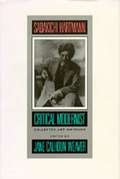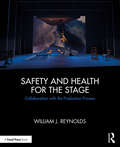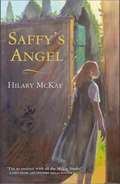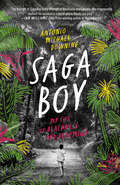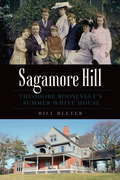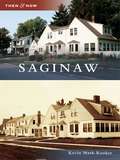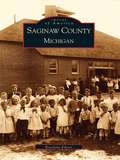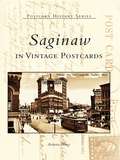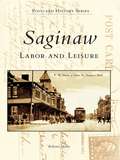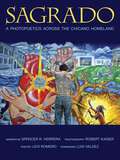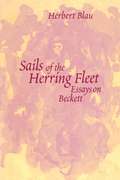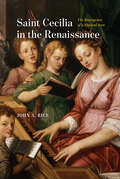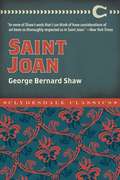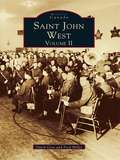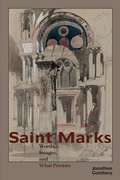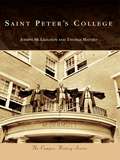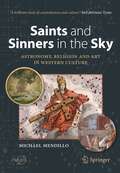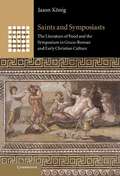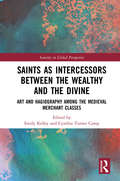- Table View
- List View
Sadakichi Hartmann, Critical Modernist: Collected Art Writings
by Jane Calhoun WeaverBrilliant and controversial, art critic Sadakichi Hartmann wrote copiously about American and European art and the shaping of American culture during the decades from 1890 to 1910. Jane Weaver has recovered and assembled over fifty of Hartmann's critical writings from influential, though often obscure, turn-of-the-century journals. These reviews and theoretical essays not only provide some of the earliest known criticism of important artists and photographers of the period, but also make Hartmann's fundamental- and uniquely American- definition of modernism available to students of art and cultural history. A most useful adjunct to the text is a complete bibliography of Hartmann's writings on art, as well as an annotated checklist of all the artists treated by Hartmann in this book. Sadakichi Hartmann (1867-1944), half German, half Japanese, learned the American cast of mind and heart as a beloved young disciple of the aged Walt Whitman. Reflecting the poet's zealous vision, Hartmann's piercing commentaries on the art centers of Boston and New York offer unparalleled documentation of the years before and after 1900.
Safe Gun Ownership For Dummies
by Greg LickenbrockA straightforward guide to being smart with your firearm With gun sales at an all-time high in the U.S., easy-to-understand advice on storing and possessing guns safely is at an all-time premium. Safe Gun Ownership For Dummies paves the way for new and novice gun owners to learn the basics of firearm ownership in a non-partisan tone. This book helps gun owners thoroughly explore the rules of gun safety and adopt the habits of savvy firearm aficionados. Written by a firearms expert and analyst who has reviewed hundreds of firearms along with gun safety and storage options, this guide helps you develop a safety mindset and apply practices to assure you and your family avoid harm. Learn, internalize, and apply the rules of gun safety Understand federal, state, and local gun laws Find a good gun safety course for hands-on practice Store and transport your firearm securelyWhen it’s time to start training on your new firearm and the safety rules of gun ownership, Safe Gun Ownership For Dummies is at the ready with everything you need to know to make safety your aim.
Safe Houses and the Underground Railroad in East Central Ohio
by Janice Vanhorne-LaneFor slaves fleeing captivity, the Underground Railroad was the most viable means of escape, and with over three thousand miles of clandestine routes and secret trails, Ohio had the country's most extensive network of safe houses. A great number of these passageways were concentrated throughout the state's east central region, particularly the inland channels of Coshocton, Holmes and Guernsey Counties and the now-famous canal route, a major conduit winding through Tuscarawas and Stark Counties. Similarly, runaways sought refuge in the hills and valleys of Harrison County, as well as in the Quaker stronghold of Columbiana County. Using the letters of Wilbur H. Seibert, along with contemporary photographs of area safe houses, Janice VanHorne-Lane provides an intimate account of east central Ohio's profound contributions to the Underground Railroad and its mission, freedom for all.
Safety Orange (Forerunners: Ideas First)
by Anna Watkins FisherHow fluorescent orange symbolizes the uneven distribution of safety and risk in the neoliberal United States Safety Orange first emerged in the 1950s as a bureaucratic color standard in technical manuals and federal regulations in the United States. Today it is most visible in the contexts of terror, pandemic, and environmental alarm systems; traffic control; work safety; and mass incarceration. In recent decades, the color has become ubiquitous in American public life—a marker of the extreme poles of state oversight and abandonment, of capitalist excess and dereliction. Its unprecedented saturation encodes the tracking of those bodies, neighborhoods, and infrastructures judged as worthy of care—and those deemed dangerous and expendable. Here, Anna Watkins Fisher uses Safety Orange as an interpretive key for theorizing the uneven distribution of safety and care in twenty-first-century U.S. public life and for pondering what the color tells us about neoliberalism&’s intensifying impact often hiding in plain sight in ordinary and commonplace phenomena. Forerunners: Ideas First is a thought-in-process series of breakthrough digital publications. Written between fresh ideas and finished books, Forerunners draws on scholarly work initiated in notable blogs, social media, conference plenaries, journal articles, and the synergy of academic exchange. This is gray literature publishing: where intense thinking, change, and speculation take place in scholarship.
Safety and Health for the Stage: Collaboration with the Production Process
by William J. ReynoldsSafety and Health for the Stage: Collaboration with the Production Process is a practical guide to integrating safety and health into the production process for live entertainment in the context of compliance with applicable codes, standards, and recommended practices. This book explores the need for safety and health to become an integral aspect of theatre production and live entertainment, focusing on specific steps to take and policies to employ to bring a safety and health program into full collaboration in the production process. Readers will learn how to comply with legal codes and standards as they initiate and implement an effective safety and health program in their theatre production organization or academic theatre department. The book includes references and links to other industry-specific safety and health resources, as well as a Glossary of Safety and Health Terms to navigate the safety and health jargon in the context of theatre and live entertainment. Safety and Health for the Stage: Collaboration with the Production Process provides links to electronic versions of sample safety and health programs, industry-specific policies and recommended practices, and forms and templates related to many of the topics covered in the book. Written for practitioners who are engaged in all aspects of theatre production and live entertainment, as well as educators who train and influence the next generations of these practitioners, this book is an essential resource for creating a positive culture of safety in live entertainment.
Saffy's Angel (Casson Family #1)
by Hilary MckayThe four Casson children, whose mother, Eve, is a fine-arts painter, have all been given the names of paint colors. Cadmium (Caddy), is the eldest; then Saffron (Saffy); Indigo, the only boy; and Rose, the youngest. When Saffy discovers quite by accident that she has been adopted, she is deeply upset, though the others assure her that it makes no difference at all. Saffy is the daughter of Eve's twin sister, who lived in Siena, Italy, and died in a car crash. Grandad brought Saffy, as a very small child, back from Siena. At Grandad's death he leaves something to each of the children. To Saffy, it is "her angel," although no one knows its identity. How Saffy discovers what her angel is, with the help of an energetic new friend, lies at the heart of this enchanting story. Unforgettable characters come alive in often deeply humorous and always absorbing events to be treasured for a long, long time.
Saga Boy: My Life of Blackness and Becoming
by Antonio Michael DowningThe triumph of Saga Boy is the triumph of Blackness everywhere--the irrepressible instinct for survival in a world where Blacks are prey."--Ian Williams, Giller Prize-winning author of ReproductionAn enthralling, deeply personal account of a young immigrant's search for belonging and black identity amid the long-lasting effects of cultural dislocation.Antonio Michael Downing's memoir of creativity and transformation is a startling mash-up of memories and mythology, told in gripping, lyrical prose. Raised by his indomitable grandmother in the lush rainforest of southern Trinidad, Downing, at age 11, is uprooted to Canada when she dies. But to a very unusual part of Canada: he and his older brother are sent to live with his stern, evangelical Aunt Joan, in Wabigoon, a tiny northern Ontario community where they are the only black children in the town. In this wilderness, he begins his journey as an immigrant minority, using music and performance to dramatically transform himself. At the heart of his odyssey is the longing for a home. He is re-united with his birth parents who he has known only through stories. But this proves disappointing: Al is a womanizing con man and drug addict, and Gloria, twice abandoned by Al, seems to regard her sons as cash machines. He tries to flee his messy family life by transforming into a series of extravagant musical personalities: "Mic Dainjah", a punk rock rapper, "Molasses", a soul music crooner and finally "John Orpheus", a gold chained, sequin- and leather-clad pop star. Yet, like his father and grandfather, he has become a "Saga Boy", a Trinidadian playboy, addicted to escapism, attention, and sex. When the inevitable crash happens, he finds himself in a cold, stone jail cell. He has become everything he was trying to escape and must finally face himself. Richly evocative, Saga Boy is a heart-wrenching but uplifting story of a lonely immigrant boy who overcomes adversity and abandonment to reclaim his black identity and embrace a rich heritage.
Sagamore Hill: Theodore Roosevelt's Summer White House (Landmarks)
by Bill BleyerNo house better reflects the personality and interests of its owner than Theodore Roosevelt's cherished Sagamore Hill. After Roosevelt returned to Oyster Bay following the death of both his beloved wife and mother, he and his second wife, Edith, made the house a home for their growing and rambunctious family. What began as the perfect getaway from unhealthy New York City summers in his grandfather's day became the Summer White House during Roosevelt's presidency. He hosted political guests like Henry Cabot Lodge and cultural luminaries like novelist Edith Wharton. Roosevelt spent his final years happily at Sagamore Hill, and after his death in 1919, the Theodore Roosevelt Association and the National Park Service preserved the house. With previously unpublished photographs and a detailed guide to the house and grounds, historian Bill Bleyer recounts bygone days at Roosevelt's haven.
Saginaw
by Kevin Mark RookerSaginaw is the hub of mid-Michigan and had its beginnings in the 1820s with the establishment of Fort Saginaw near present-day Court and Hamilton Streets. Owing to the lumber industry, two separate cities developed along the banks of the Saginaw River: the west side city of Saginaw and East Saginaw. Intense rivalry resulted in rapid population growth and many civic improvements for both. Consolidation of the Saginaws occurred in 1890, and continued prosperity followed the ebb and flow of the lumber and automotive industries.
Saginaw County, Michigan
by Roselynn EdererAs part of the Northwest Territory, the Saginaw wilderness was not organized into a county until January 28, 1835. When Canadian, Scottish, German, and Irish pioneers began to settle along the region's many rivers, small communities developed-Burt, Birch Run, Bridgeport, Frankenmuth, Freeland, Hemlock, Merrill, St. Charles, Chesaning, Oakley, and Zilwaukee-in addition to larger towns such as Carrollton, Saginaw City, and East Saginaw. Using stories and photographs collected from life-long residents and historical societies throughout Saginaw County, this book documents the colorful lumbering, agricultural, and industrial past of these communities from the mid-1800s through the early 1900s.
Saginaw in Vintage Postcards (Postcard History)
by Roberta MoreyBecause of its excellent river system, Saginaw developed from an Indian village into a bustling lumber town. In its early days, investors came from eastern cities and became wealthy lumber barons. They built beautiful mansions, hotels, and public buildings while they also supported civic projects. Before consolidating, there were two cities: East Saginaw and Saginaw City, separated by the Saginaw River. Many German societies, schools, and churches were organized in the area, due to the large number of residents with a German heritage. The early residents survived fires, floods, and the end of the lumber boom. Other industries developed and the city continued to grow. The rare postcards that appear in this book depict many historical buildings, the two separate cities, the German influence, and the philanthropy of the lumber barons. Join author Roberta Morey on a journey through Saginaw's rich industrial and cultural history.
Saginaw: Labor and Leisure
by Roberta MoreySaginaw boasts a rich and colorful history. After the early explorers and small Native American villages came the lumbermen, shanty boys, and a bustling commercial center. Later the coal, salt, and sugar beet industries replaced lumbering in the economy. Many of Saginaw's businesses were known worldwide and are still important after more than 100 years. Saginaw was home to a bevy of famous and infamous characters. Among the early ruffians were Fabian Fournier (Saginaw's Paul Bunyan), Silver Jack Driscoll, and the Opera House Rogue, Warren Bordwell. Saginaw's more illustrious residents include "King Clothier," Little Jake Seligman, educator Alice Freeman Palmer, boxer George "Kid" Lavigne, and many others. Many of the postcards in this book represent the businesses and personalities that made Saginaw's distinctive character what it is today.
Sagrado: A Photopoetics Across the Chicano Homeland (Querencias Series)
by Spencer R. Herrera Romero LeviUn lugar sagrado, a sacred place where two or more are gathered in the name of community, can be found almost anywhere and yet it is elusive: a charro arena behind a rock quarry, on the pilgrimage trail to Chimayó, a curandero&’s shrine in South Texas, or at a binational Mass along the border. Sagrado is neither a search for identity nor a quest for a homeland but an affirmation of an ever-evolving cultural landscape. Embedded at the heart of this remarkable book, in which prose, photographs, and poems complement each other, is a photopoetic journey across the Chicano Southwest.
Sails of the Herring Fleet
by Herbert BlauSails of the Herring Fleet traces esteemed director and theorist Herbert Blau's encounters with the work of Samuel Beckett. Blau directed Beckett's plays when they were still virtually unknown, and for more than four decades has remained one of the leading interpreters of his work. In addition to now-classic essays, the collection includes early program notes and two remarkable interviews -- one from Blau's experience directing Waiting for Godot at San Quentin prison, and one from his last visit with Beckett, just before the playwright's death. Herbert Blau is Byron W. and Alice L. Lockwood Professor of the Humanities, University of Washington.
Saint Cecilia in the Renaissance: The Emergence of a Musical Icon
by John A. RiceThis study uncovers how Saint Cecilia came to be closely associated with music and musicians. Until the fifteenth century, Saint Cecilia was not connected with music. She was perceived as one of many virgin martyrs, with no obvious musical skills or interests. During the next two centuries, however, she inspired many musical works written in her honor and a vast number of paintings that depicted her singing or playing an instrument. In this book, John A. Rice argues that Cecilia’s association with music came about in several stages, involving Christian liturgy, visual arts, and music. It was fostered by interactions between artists, musicians, and their patrons and the transfer of visual and musical traditions from northern Europe to Italy. Saint Cecilia in the Renaissance explores the cult of the saint in Medieval times and through the sixteenth century when musicians’ guilds in the Low Countries and France first chose Cecilia as their patron. The book then turns to music and the explosion of polyphonic vocal works written in Cecilia’s honor by some of the most celebrated composers in Europe. Finally, the book examines the wealth of visual representations of Cecilia especially during the Italian Renaissance, among which Raphael’s 1515 painting, The Ecstasy of Saint Cecilia, is but the most famous example. Thoroughly researched and beautifully illustrated in color, Saint Cecilia in the Renaissance is the definitive portrait of Saint Cecilia as a figure of musical and artistic inspiration.
Saint George Between Empires: Image and Encounter in the Medieval East
by Heather A. BadamoThis volume examines Saint George’s intertwined traditions in the competing states of the eastern Mediterranean and Transcaucasia, demonstrating how rival conceptions of this well-known saint became central to Crusader, Eastern Christian, and Islamic medieval visual cultures.Saint George Between Empires links the visual cultures of Byzantium, North Africa, the Levant, Syria, and the Caucasus during the Crusader era to redraw our picture of interfaith relations and artistic networks. Heather Badamo recovers and recontextualizes a vast body of images and literature—from etiquette manuals and romances to miracle accounts and chronicles—to describe the history of Saint George during a period of religious and political fragmentation, between his “rise” to cross-cultural prominence in the eleventh century and his “globalization” in the fifteenth. In Badamo’s analysis, George emerges as an exemplar of cross-cultural encounter and global translation.Featuring important new research on monuments and artworks that are no longer available to scholars as a result of the occupation of Syria and parts of Iraq, Saint George Between Empires will be welcomed by scholars of Byzantine, medieval, Islamic, and Eastern Christian art and cultural studies.
Saint Joan: Her History And The Play (Clydesdale Classics)
by George Bernard ShawRediscover the story of the inspirational Saint Joan of Arc with the classic play by George Bernard Shaw. The historical saint begins her story as a simple country girl in fifteenth century France who is inspired by visions from God to help liberate her country from the English. She secures soldier&’s clothing and convinces the soon-to-be king, Charles, to begin battling for his country. Though her regiment succeeds in battle after battle, her enemies (the English) move against her. When Joan moves to liberate Paris from the English control—against the advice of her friends—she is captured and tried for heresy. Despite help from a Bishop and the Inquisitor, who truly want to see Joan succeed, her beliefs simply do not match with the Church; people do not hear visions from God, only from the church, therefore Joan must be possessed by demons. Subsequently, Joan is sentenced to death. Now read this beautiful new edition of the talented George Bernard Shaw&’s play, Saint Joan. Discover why the Catholic Church made this young woman into one of the most famous saints known today.
Saint John West: Volume II (Historic Canada)
by David Goss Fred MillerSaint John West Volume II adds to and continues the story of the West Side's struggle for existence. Always dependent on seasonal industry, initially fishing and shipbuilding and later the railway and seaport, the area has seen high and low points in its 200-plus years of existence. At one time, residents imagined times would become so prosperous that King Street would be transformed into a major boulevard paved with gold and Courtenay Hill would be the site of a huge, decorative cathedral dedicated to the inner spirit. In reality, the fish have stopped coming, the wooden ships are no longer built, and the Canadian Pacific railway that provided hundreds of jobs and promised such hope has left the Maritimes. Changing trade patterns and political favours to keep the St. Lawrence open to Montreal has devastated the winter-port operations. Many Saint John West residents have had to close their businesses and move on. Others were displaced when the construction of the Harbour Bridge tore three full blocks out of the heart of the community in 1968. Still others have chosen to remain, and today, though little industry exists, the area is still vibrant and working hard to hold together some vestige of the pride of former times.
Saint John's Abbey Church: Marcel Breuer and the Creation of a Modern Sacred Space
by Victoria M. YoungIn the 1950s the brethren at the Benedictine Abbey of Saint John the Baptist in Collegeville, Minnesota—the largest Benedictine abbey in the world—decided to expand their campus, including building a new church. From a who&’s who of architectural stars—such as Walter Gropius, Richard Neutra, Pietro Belluschi, Barry Byrne, and Eero Saarinen—the Benedictines chose a former member of the Bauhaus, Marcel Breuer. In collaboration with the monks, this untested religious designer produced a work of modern sculptural concrete architecture that reenvisioned what a church could be and set a worldwide standard for midcentury religious design. Saint John&’s Abbey Church documents the dialogue of the design process, as Breuer instructed the monks about architecture and they in turn guided him and his associates in the construction of a sacred space in the crucial years of liturgical reform. A reading of letters, drawings, and other archival materials shows how these conversations gave shape to design elements from the church&’s floor plan to the liturgical furnishings, art, and incomparable stained glass installed within it. The book offers a rare detailed view of how a patron and architect work together in a successful building campaign—one that, in this case, lasted for two decades and resulted in designs for twelve buildings, ten of which were completed.The post–World War II years were critical in the development of religious and architectural experiences in the United States—experiences that came together in the construction of Saint John&’s Abbey and University Church and that find their full expression in Victoria M. Young&’s account of the process. Using the liturgy of the mid-twentieth century as a cornerstone for understanding the architecture produced to support it, her book showcases the importance of modernism in the design of sacred space, and of Marcel Breuer&’s role in setting the standard.
Saint Marks: Words, Images, and What Persists
by Jonathan GoldbergSaint Marks invokes and pluralizes the figure of Mark in order to explore relations between painting and writing. Emphasizing that the saint is not a singular biographical individual in the various biblical and hagiographic texts that involve someone so named, the book takes as its ultimate concern the kinds of material life that outlive the human subject.From the incommensurate, anachronic instances in which Saint Mark can be located—among them, as Evangelist or as patron saint of Venice—the book traces Mark’s afterlives within art, sacred texts, and literature in conversation with such art historians and philosophers as Aby Warburg, Giorgio Agamben, Georges Didi-Huberman, T. J. Clark, Adrian Stokes, and Jean-Luc Nancy. Goldberg begins in sixteenth-century Venice, with a series of paintings by Gentile and Giovanni Bellini, Tintoretto, and others, that have virtually nothing to do with biblical texts. He turns then to the legacy of John Ruskin’s Stones of Venice and through it to questions about what painting does as painting. A final chapter turns to ancient texts, considering the Gospel of St. Mark together with its double, the so-called Secret Gospel that has occasioned controversy for its homoerotic implications.The posthumous persistence of a life is what the gospel named Mark calls the Kingdom of God. Saints have posthumous lives; but so too do paintings and texts. This major interdisciplinary study by one of our most astute cultural critics extends what might have been a purely theological subject to embrace questions central to cultural practice from the ancient world to the present.
Saint Peter's College
by Joseph Mclaughlin Thomas MatteoSaint Peter's College was founded in 1872 by the Jesuits as a Catholic liberal arts college for men. Situated in an urban setting, the college seeks to develop the whole person in preparation for a lifetime of learning, leadership, and service in a diverse and global society. In 1966, Saint Peter's became coeducational and today educates students from 65 countries all over the world. Committed to academic excellence and individual attention, Saint Peter's College provides education, informed by values, primarily in degree-granting programs in the arts, sciences, and business to resident and commuting students from a variety of backgrounds.
Saint Spotting: Or How To Read A Church
by Chris RaschkaA church is a weighty thing, isn&’t it? Its doors are heavy and hard to budge. Its walls are made of stone. And there may be strange or even scary pictures inside. How can a small person make sense of these intimidating places? Two-time Caldecott medalist Chris Raschka shares his mother&’s wonderful way of visiting a church: what they would call saint spotting. Each visit to a church becomes an adventure, a trip through the stories that have shaped centuries of faith.Playful and poignant, this beautifully illustrated book introduces readers to saints and symbols through the warm bond between a mother and son. From bookish Paul to faithful Mary Magdalene, from musical Cecilia to animal-loving Francis, there&’s a fascinating saint to discover in every corner.
Saints and Sinners in the Sky: Astronomy, Religion and Art in Western Culture (Springer Praxis Books)
by Michael Mendillo"A brilliant study of constellations and culture." - Neil deGrasse TysonIn this book, Boston University Professor of Astronomy Michael Mendillo takes readers deep into the annals of history, showing how visual depictions of the heavens evolved in tandem with science and religion throughout much of Western culture. With unprecedented scope and scale, Professor Mendillo explores how cave art, illuminated manuscripts, sculptures, paintings and architecture reflected some of the great religious and secular battles taking place over the course of centuries. Enter a world of biblical proportions, where constellations of ancient heroes and pagans were thoroughly recast as Christian saints and the Twelve Apostles. This nontechnical narrative brings vitality and accessibility to some of the most enduring subjects in human history, offering a lively new exploration of the visual connections between celestial phenomena and artistic expression."Saints and Sinners impressionistically reveals the connections of art, astronomy, and religion in Western culture to illuminate the age-old quest for celestial-terrestrial connections.” - Roberta J.M. Olson, author of Giotto’s Portrait of Halley’s Comet and Cosmos: The Art and Science of the Universe “Professor Mendillo’s book does a priceless service, opening the doors of our minds to images that will stir us, because the heavens are part of us, and we all long to know how and why.” - Rev. David R. Thom, MIT Chaplain and Convener of the Cambridge Faculty Roundtable on Science, Art & Religion "Over a lifetime devoted to astronomical research and teaching, Michael Mendillo has indulged a parallel passion for artistic representations of the heavenly bodies. In this sumptuous volume, he explores the projection of our changing belief systems onto the constant stars.” - Dava Sobel, author of Longitude, Galileo’s Daughter and The Glass Universe
Saints and Symposiasts
by Jason KönigGreek traditions of writing about food and the symposium had a long and rich afterlife in the first to fifth centuries CE, in both Greco-Roman and early Christian culture. This book provides an account of the history of the table-talk tradition, derived from Plato's Symposium and other classical texts, focusing among other writers on Plutarch, Athenaeus, Methodius and Macrobius. It also deals with the representation of transgressive, degraded, eccentric types of eating and drinking in Greco-Roman and early Christian prose narrative texts, focusing especially on the Letters of Alciphron, the Greek and Roman novels, especially Apuleius, the Apocryphal Acts of the Apostles and the early saints' lives. It argues that writing about consumption and conversation continued to matter: these works communicated distinctive ideas about how to talk and how to think, distinctive models of the relationship between past and present, distinctive and often destabilising visions of identity and holiness.
Saints as Intercessors between the Wealthy and the Divine: Art and Hagiography among the Medieval Merchant Classes (Sanctity in Global Perspective)
by Emily Kelley Cynthia Turner CampOffering snapshots of mercantile devotion to saints in different regions, this volume is the first to ask explicitly how merchants invoked saints, and why. Despite medieval and modern stereotypes of merchants as godless and avaricious, medieval traders were highly devout – and rightly so. Overseas trade was dangerous, and merchants’ commercial activities were seen as jeopardizing their souls. Merchants turned to saints for protection and succor, identifying those most likely to preserve their goods, families, reputations, and souls. The essays in this collection, written from diverse angles, range across later medieval western Europe, from Spain to Italy to England and the Hanseatic League. They offer a multi-disciplinary examination of the ways that medieval merchants, from petty traders to influential overseas wholesalers, deployed the cults of saints. Three primary themes are addressed: danger, community, and the unity of spiritual and cultural capital. Each of these themes allows the international panel of contributors to demonstrate the significant role of saints in mercantile life. This book is unique in its exploration of saints and commerce, shedding light on the everyday role religion played in medieval life. As such, it will be of keen interest to scholars of religious history, medieval history, art history, and literature.
